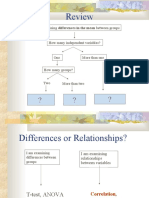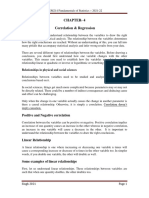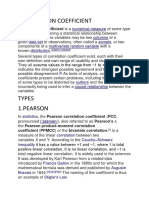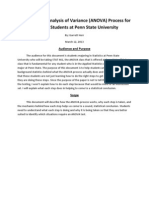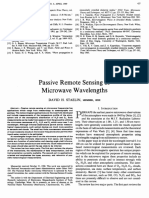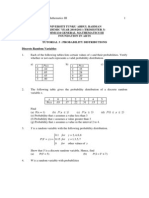Interpretation: of Correlation Coefficient
Interpretation: of Correlation Coefficient
Uploaded by
Murli IngleCopyright:
Available Formats
Interpretation: of Correlation Coefficient
Interpretation: of Correlation Coefficient
Uploaded by
Murli IngleOriginal Description:
Original Title
Copyright
Available Formats
Share this document
Did you find this document useful?
Is this content inappropriate?
Copyright:
Available Formats
Interpretation: of Correlation Coefficient
Interpretation: of Correlation Coefficient
Uploaded by
Murli IngleCopyright:
Available Formats
Interpretation of the Correlation
Coefficient: A Basic Review
RICHARD TAYLOR, EDD, RDCS
A basic consideration in the evaluation of professional medical literature is being able to understand the
statistical analysis presented. One of the more frequently reported statistical methods involves correlation analysis where a correlation coefficient is reported representing the degree of linear association between two variables. This article discusses the basic aspects of correlation analysis with examples given from professional journals and focuses on the interpretations and limitations of the correlation coefficient. No attention was given to the actual calculation of this statistical value.
Key words: correlation coefficient, r coefficient, regression equation, coefficient of determination.
The review of any medical or scientific journal articles cannot be undertaken without being constantly subjected to the statistical analysis and interpretation of research data. Often the trauma of these mysterious numbers and symbols can be avoided by simply reading the abstract containing the summary and conclusions. Even then, statistical terms and symbols that require at least a minimal
understanding of the statistical concepts are frequently reported in the abstract summary. For example, in a journal article about the echocardiographic analysis of prosthetic valve replacements, it was noted in the abstract that valvular gradients correlated with prosthetic size (r 0.57) and were higher (P < 0.001) across small (19 to 23 mm) versus large (25 to 31 mm) valves. To fully understand the clinical significance of this research finding would require some knowledge of what the statistical symbols represented and an interpreta=
tion of the
given statistical values.
Logan,
Department of Cardiology, Logan General Hospital, Virginia. Correspondence: Richard Taylor, EdD, RDCS, Cardiac Laboratory, Logan General Hospital, Logan, WV 25601.
From the West
Ideally, good course in basic statistics would be helpful for all sonographers. This is particularly relevant to those who are consumers of the published literature and research in the various specialties. However, this is not always possible; publications like the recent JDMS article by Khamis2 give some valuable help and insight into the statistical puzzle. This article only touched on one piece of the puzzle as the author masterfully explained the meaning of the P value and its relationship to the test hypothesis. It is my hope that another part of the puzzle can be added to help understand more fully the statistical presentations often encountered in our professional
a
journals.
35
36
Correlation analysis is one of the most widely used and reported statistical methods in summarizing medical and scientific research data. In this article the basic aspects of correlation analysis will be reviewed with emphasis placed upon the interpretations and limitations of the correlation coefficient. No focus will be given to the actual calculation of this statistical value. It is often useful to determine if a relationship exists between two different variables. If so, how significant or how strong is this association between the two variables? For example, is there a relationship between the years of service as a sonographer and scores achieved on the registry examination? The correlation coefficient or r coefficient is a statistic used to measure the degree or strength of this type of relationship. As previously mentioned, this important statistic is reported extensively in the health science journals. The following examples serve to illustrate this point: " ID="I2.21.2">"A correlation coefficient of 0.94 was noted between the Doppler-derived transaortic gradient and the catheterization-derived transaortic gradient in the evaluation of 30 adult patients with aortic " ID="I2.25.2">stenosis."3 The reported correlation (r 0.92) between the echocardiographically and hemodynamically derived mitral valve areas was statistically significant.4 In these examples, statistical correlation analysis was used to determine the strength of the association between clinical data which was derived noninvasively (Doppler echocardiography) compared with invasively derived data (catheterization) to evaluate valvular stenosis. The clinical feasibility of a strong correlation between these two sets of data or variables should be obvious. Intuition and empirical observation may indicate that certain variables are linearly related, but in its most basic sense the coefficient of correlation measures the degree to which the two variables are related. 5 The correlation coefficient is often referred to as Pearsons product-moment r or r coefficient.6 The correlation r value requires both a magnitude and a direction of either positive or negative. It may take on a range of values from -1 to 0 to +1, where the values are absolute and nondimensional with no units involved. A correlation coefficient of zero indicates that no association exists between the measured variables. The closer the r coefficient approaches 1, regardless of the direction, the stronger is the existing association indicating a more linear relationship between the
=
FIG. 1A through F. Examples of various values of r. Each graph illustrates the correlation indicated by the specific
r-value equation shown.
variables. The strength of the correlation is on the direction or the sign. Thus, r 0.90 and r -0.90 are equal in the degree of association of the measured variables. A positive correlation coefficient indicates that an increase in the first variable would correspond to an increase in the second variable, thus implying a direct relationship between the variables. A negative correlation indicates an inverse relationship whereas one variable increases, the second variable decreases. A graph can be useful to illustrate the concept of correlation and to visualize the relationship which exists between the variables. For illustration purposes, two variables are labeled as variable x and variable y and plotted on a graph. Figure 1 illustrates some different sets of data and how they are summarized by a correlation coefficient value or r coefficient. Note that in real-world situations, x and y would represent the two variables being statistically analyzed such as high school GPA versus SAT scores, or the level of blood serum cholesterol versus heart disease risk to determine the degree of the relationship. Figure la illustrates a perfect positive correlation of r = 1.0. It can be noted that all data observations
two not
=
dependent
37
fall on a line, thereby the term perfect linear correlation becomes appropriate. The correlation is positive in direction because as variable x increases, variable y varies in the same direction. The relationship of the variables in Figure 1d is also a perfect correlation, but negative in direction (r -1.0). All the data observations still lie on a single line, but as variable x increases, variable y decreases. An example of a negative correlation might involve the number of pull-ups performed relative to the percentage of body fat whereas with body fat percentage increases, a decrease in the number of pull-ups is observed. " ID="I3.13.4">"In real life, there are always random variations in our observations; hence, a perfect linear relationship is extremely " ID="I3.15.6">rare."6 Although the r coefficient value is no longer perfect, the correlation remains higher as the data observations fall closer to a straight line (Fig. 1c) and the coefficient value decreases as the data points deviate more from the straight line (Fig.1e). If there is no linear relationship between the variables, r will be virtually zero and the data points on the corresponding graph will be randomly scattered and approximate a circle (Fig. ib). It is important to understand that it is possible to obtain a nonzero value for r even when no correlation actually exists.5 Also, good to high correlations exist
=
significance vary as to the sample size used and the level of significance. If it could be assumed that the observed correlation of r 0.55 mentioned previously came from 35 interval-scaled paired observations which were obtained randomly, and that both x and y variables are normally distributed, then it could be concluded that variables x and y represent a correlation coefficient (r 0.55) which is significantly (P < .01) different from zero. In other words, the relationship existing between these variables is statistically significant. However, to add to the difficulty of correlation
= =
interpretations, important
one.
correlation coefficient is
A
statistically significant not necessarily an statistically significant r
though they are less than a perfect 1.0. Now what about the statistical significance of those correlation coefficients other than zero and r
even
=
1.0?
Like any statistical value, the correlation coefficient is of little importance unless it can be properly interpreted. Like all scale values, the correlation coefficient is difficult to interpret. Labeling systems exist to roughly categorize r values where correlation coefficients (in absolute value) which are <_ 0.35 are generally considered to represent low or weak correlations, 0.36 to 0.67 modest or moderate correlations, and 0.68 to 1.0 strong or high correlations with r coefficients > 0.90 very high correlations. 5,7 However, merely describing a correlation coefficient of r 0.55 as a moderate correlation is not meaningful. A basic question which needs to be answered relates to the statistical significance of the correlation coefficient and the random chance of observing a given value of r when, in fact, no real correlation exists. Statistical tables exist which define what r coefficients must be observed before the correlation is said to be statistically significant.5 The critical values for correlation statistical
=
coefficient merely indicates that the observed sample data provides ample evidence to reject the null hypothesis that the population correlation coefficient parameter (rho) is zero thereby concluding that the population correlation coefficient is not equal to zero. For example, given a large sample size (n > 100), a correlation coefficient as small as r 0.20 can be significantly different from zero at a 0.05. This degree of linear correlation would have little practical importance as we shall see later. It can be seen that the correlation coefficient is an abstract measure and not given to a direct precise interpretation. It can be said that the higher the absolute value of the correlation coefficient, the stronger the relationship. Although the correlation coefficient is the best known and subject to statistical testing, perhaps the coefficient of determination is more meaningful.8 The coefficient of determination can be used to more fully interpret r and is obtained by simply squaring the correlation coefficient r. The coefficient of determination (r2) is defined as the percent of the variation in the values of the dependent variable (y) that can be "explained" by variations in the value of the independent variable (X).5,7,8 This technique results in a percent value which makes it easier to interpret more precisely. Thus, if a correlation coefficient of r 0.20 was observed between variable x and variable y, then the coefficient of determination is r2 0.04. This means that only 4% of the total variation in variable y can be explained or accounted for by variation in 0.20 variable x. Therefore, even though the r 0.05 with a large at a was statistically significant sample in the example noted above, it can be seen that only 4% of the total variation of variable y
= = =
= =
38
be explained by variation in x. The coefficient of determination technique is a more conservative measure of the relationship between the two variables and is preferred by many statisticians, but is seldom reported in research data statistical
can
regression analysis. A mathematical equation is developed for the line of best fit representing the data. From this regression equation, prediction
becomes possible where either variable can be predicted based on a value of the other variable. Predicting unknown values (dependent variable) from given values (independent variable) is common and widely used in medical science as well as business forecasting, economics, and education. For example, a research study abstract reported that the correlation between Doppler pressure halftime measurements for mitral valve
to
area
analyses.
As is true of all statistical methods and proce-
dures, correlation analysis is subject to limitations and misinterpretations that can be serious. In addition to the limitations previously noted, it must
be understood that although it measures how the variable points approximate a straight line, it does not validly measure the strength of a nonlinear relationship.6 Spurious or accidental associations between variables may also exist. Browner and Newman9 wrote that, " ID="I4.16.6">"It is a mistake to believe a research hypothesis just because the P value is statistically " ID="I4.18.5">significant." This is particularly true when low prior probability makes a particular association unrealistic or "unsuspected." They noted that the finding of a significant P value dealing with a correlation between coffee drinking and pancreatic cancer (P < .05) did not establish the truth of the research hypothesis; subsequent studies failed to confirm the association. Research problems such as data contamination, lab error, sample bias, or poor research design could also cause problems with reliable conclusions. One of the most frequent and serious misuses of correlation analysis is to interpret a high correlation between variables as a cause-and-effect relationship.6,8 Correlation analysis measures a relationship or association; it does not define the explanation or its basis. For instance, there is a significant association between a childs foot size and handwriting ability, but it might be presumptuous to claim a large foot causes better handwriting.6 Statistics do not lie, but they sometimes lead us to reaching false conclusions. Caution must be exercised to avoid this pitfall. Statistical data might indicate that 99.9% of all people who died of cancer drank some water within the previous month. The data speaks for itself, but it would be easy to be deceived into believing that a cause-andeffect relationship, however ridiculous, exists here. In correlation analysis, the purpose is to measure the closeness of the linear relationship between the defined variables. The correlation coefficient indicates how closely the data fit a linear pattern. Generally, correlation analysis also includes further investigation into defining the pattern of the existing relationship. This procedure is known as
closely
relative
=
catheterization
=
measurements
was
good (r
84x + 0.17).10 Upon interpreting this 0.85, y correlation analysis, we see a statistically significant linear relationship (r 0.85, P <.001) which exists between the Doppler evaluation of mitral valve area and catheter-derived mitral valve areas. The r coefficient would fall into a general category label of "high" and would yield a coefficient of determination (r2) or 0.72 or 72%, meaning that 72% of the variability noted in catheterization-derived mitral valve area measurements could be accounted for by Doppler pressure half-time method. Therefore, it appears we have a good association here of clinical usefulness. Finally, the pattern of the linear relationships between Doppler compared with catheter measurements for mitral area assessment is defined by the regression equation 0.84x + 0.17 where x = Doppler pressure halfy time mitral valve area and y catheterization-derived mitral valve area. Therefore, if we determine the value for Doppler pressure half-time mitral area to be 1.2 cm2, then the catheterization-derived area (y) could be predicted to be 1.18 cm2 [0.84 (1.2) + 0.17]. Correlation is important here also because the closer the data "fits" the line, that is the higher the correlation coefficient, the better the predictions become as to reducing the potential errors. It should be noted that although correlation analysis often routinely includes regression analysis in the "package," it is possible to focus on either correlation coefficients or regression
=
equations independently.
Although beyond the scope of this article, different formulas exist to calculate the coefficient of correlation depending upon the nature of the variables and samples. Computer programs are available to routinely perform this task. Regardless of the technique or formula used, the interpretation of the correlation coefficient is basically the same and is generally left to the research consumer.
39
CONCLUSION
REFERENCES
1.
ability to interpret research reports and professional literature becomes hampered without a basic understanding of statistics. This article should shed some light onto a widely used statistical procedure known as correlation analysis. The purpose
of this statistical method is to give us a statistic known as the correlation coefficient which is a summary value of a large set of data representing the degree of linear association between two measured variables. This statistic serves to reduce the large amounts of data down to a manageable form for sonographers to review. For this goal to be realized, sonographers must understand what the statistical correlation coefficient represents and what it
means.
The
2. 3.
4.
5.
6.
Goldrath N, Zimes R, Vered Z: Analysis of Dopplerobtained velocity curves in functional evaluation of mechanical prosthetic valves in the mitral and aortic positions. J Am Soc Echo, 1988;1:211-225. Khamis JF: Statistics referesher II: Choice of sample size. JDMS 1989;4:176-183. Stamm BR, Martin RP: Quantification of pressure gradients across stenotic valves by Doppler ultraJ Am sound. Coll Cardiol 1983;2:707-718. Martin RP, Rakowski H, Kleiman JH, et al: Reliability and reproducibility of two-dimensional echocardiographic measurement of the stenotic mitral valve orifice area. Am J Cardiol 1979;43:560-568. Weber JC, Lamb DR: Statistics and Research in Physical Education. St. Louis: CV Mosby Co, 1970, pp 59-64, 222. Kuma JW: Basic Statistics for the Health Sciences. Palo Alto:
Mayfield Publishing Co., 1984, pp 158-169.
RO, Lind DA, Marchal WG: Statistics: An Introduction. New York: Harcourt Brace Jovanovich, Inc, 1983, pp 368-383. 8. Congelosi VE, Taylor PE, Rice PF: Basic Statistics: A Real World Approach, ed 3. St. Paul: West Publishing Co, 1983,
7. Mason
ACKNOWLEDGMENTS
The author wishes to thank Alisa
Bentley,
Susan
Chafin, Betty Ellis, Anna Marshall, RN, and Brady Toler for their gracious assistance in the preparation of this manuscript.
all significant P values created equal? The analogy between diagnostic tests and clinical research. JAMA 1987;257:2459-2463. 10. Smith MD, Handshoe R, Handshoe S, et al: Comparative accuracy of two-dimensional echocardiography and Doppler pressure half-time methods in assessing severity in mitral stenosis in patients with and without prior commissurotomy. Circulation 1986;73:100-107.
pp 315-336. 9. Browner WS, Newman TB: Are
You might also like
- AP Statistics Chapter 3Document3 pagesAP Statistics Chapter 3jose mendoza0% (1)
- Compass Maritime Case AnalysisDocument31 pagesCompass Maritime Case Analysiskumar.kunal33% (6)
- Capsule Process ValidationDocument27 pagesCapsule Process Validationdr3azzam100% (4)
- Midterm1 Spring2023 AnswerkeysDocument12 pagesMidterm1 Spring2023 AnswerkeysSwaraj AgarwalNo ratings yet
- Interpretation of The Correlation Coefficient - A Basic Review PDFDocument5 pagesInterpretation of The Correlation Coefficient - A Basic Review PDFLam KCNo ratings yet
- Correlation and RegressionDocument11 pagesCorrelation and RegressiongdayanandamNo ratings yet
- Module 6 RM: Advanced Data Analysis TechniquesDocument23 pagesModule 6 RM: Advanced Data Analysis TechniquesEm JayNo ratings yet
- Correlation and Dependence: Navigation SearchDocument7 pagesCorrelation and Dependence: Navigation Searchanupam62789No ratings yet
- Review: I Am Examining Differences in The Mean Between GroupsDocument44 pagesReview: I Am Examining Differences in The Mean Between GroupsAtlas Cerbo100% (1)
- Chapter 17 Correlation and RegressionDocument16 pagesChapter 17 Correlation and RegressionKANIKA GORAYANo ratings yet
- Correlation and Regression Feb2014Document50 pagesCorrelation and Regression Feb2014Zeinab Goda100% (1)
- AP Statistics TutorialDocument12 pagesAP Statistics Tutorialkriss WongNo ratings yet
- Correlation and RegressionDocument3 pagesCorrelation and RegressionSreya SanilNo ratings yet
- Spss Tutorials: Pearson CorrelationDocument10 pagesSpss Tutorials: Pearson CorrelationMat3xNo ratings yet
- Pearson's CorrelationDocument10 pagesPearson's CorrelationmelaniekhorweichenNo ratings yet
- CorrelationDocument12 pagesCorrelationisabella343No ratings yet
- Correlation RegressionDocument5 pagesCorrelation RegressionAbrar AhmadNo ratings yet
- CH 5 - Correlation and RegressionDocument9 pagesCH 5 - Correlation and RegressionhehehaswalNo ratings yet
- Correlation and Simple Linear Regression Analyses: ObjectivesDocument6 pagesCorrelation and Simple Linear Regression Analyses: ObjectivesMarianne Christie RagayNo ratings yet
- CorrelationDocument3 pagesCorrelationAigulNo ratings yet
- Método RegresiónDocument14 pagesMétodo Regresiónel_carranza_03No ratings yet
- Correlation Anad RegressionDocument13 pagesCorrelation Anad RegressionMY LIFE MY WORDSNo ratings yet
- The Significance of CorrelationDocument6 pagesThe Significance of CorrelationEesha HadkarNo ratings yet
- What Is Correlatio1Document1 pageWhat Is Correlatio1Cheptoris SylviaNo ratings yet
- Report Statistical Technique in Decision Making (GROUP BPT) - Correlation & Linear Regression123Document20 pagesReport Statistical Technique in Decision Making (GROUP BPT) - Correlation & Linear Regression123AlieffiacNo ratings yet
- Correlation CoefficientDocument3 pagesCorrelation CoefficientbalubalubaluNo ratings yet
- Correlation AnalysisDocument51 pagesCorrelation Analysisjjjjkjhkhjkhjkjk100% (1)
- Correlation: Nidhi Pawan Tewathia Pavan Kumar PalDocument22 pagesCorrelation: Nidhi Pawan Tewathia Pavan Kumar PalPavan PalNo ratings yet
- AngilikaDocument4 pagesAngilikaGregoria MagadaNo ratings yet
- Correlation Research Design - PRESENTASIDocument62 pagesCorrelation Research Design - PRESENTASIDiah Retno Widowati100% (1)
- STATISTICS DocumentaryDocument18 pagesSTATISTICS Documentarykeerthikabalasubramanian7No ratings yet
- Correlation Coefficient: Group 5: - Willy - Intan Dani SitumorangDocument13 pagesCorrelation Coefficient: Group 5: - Willy - Intan Dani SitumorangIntan SitumorangNo ratings yet
- Stata C8Document21 pagesStata C8Dumy NeguraNo ratings yet
- Correlation Rev 1.0Document5 pagesCorrelation Rev 1.0Ahmed M. HashimNo ratings yet
- Makaku PDFDocument3 pagesMakaku PDFcacied1No ratings yet
- Datasets - Bodyfat2 Fitness Newfitness Abdomenpred: Saseg 8B - Correlation AnalysisDocument34 pagesDatasets - Bodyfat2 Fitness Newfitness Abdomenpred: Saseg 8B - Correlation AnalysisShreyansh SethNo ratings yet
- DSC 402Document14 pagesDSC 402Mukul PNo ratings yet
- Unit 4Document10 pagesUnit 4Uttareshwar SontakkeNo ratings yet
- Regression and ClassificationDocument26 pagesRegression and ClassificationDebasree RoyNo ratings yet
- Correlation Coefficient in Medical ResearchDocument6 pagesCorrelation Coefficient in Medical ResearchMyanmar LearnersNo ratings yet
- 2020 CorrelationDocument5 pages2020 CorrelationOcyub Avlas OdnamraNo ratings yet
- Forecasting Lec 6Document13 pagesForecasting Lec 6Jungle DiffNo ratings yet
- Correlation Coefficient DefinitionDocument8 pagesCorrelation Coefficient DefinitionStatistics and Entertainment100% (1)
- Short Term Training Programme On Data Analytics Using SPSS and RCMDRDocument20 pagesShort Term Training Programme On Data Analytics Using SPSS and RCMDRAr Apurva SharmaNo ratings yet
- Aem214 CH-4CDocument16 pagesAem214 CH-4CLucky GojeNo ratings yet
- Bivariate Statistics: by The End of This Sub-Topic, Learners Should Be Able ToDocument7 pagesBivariate Statistics: by The End of This Sub-Topic, Learners Should Be Able ToPrince MpofuNo ratings yet
- BRM PresentationDocument25 pagesBRM PresentationHeena Abhyankar BhandariNo ratings yet
- Introduction To Correlation and Regression Analysis: Ian Stockwell, CHPDM/UMBC, Baltimore, MDDocument8 pagesIntroduction To Correlation and Regression Analysis: Ian Stockwell, CHPDM/UMBC, Baltimore, MDRajib MukherjeeNo ratings yet
- Business Statistics Project On Correlation: Submitted by N.Bavithran BC0140018Document17 pagesBusiness Statistics Project On Correlation: Submitted by N.Bavithran BC0140018BaViNo ratings yet
- Correlation CoefficientDocument7 pagesCorrelation CoefficientDimple PatelNo ratings yet
- Correlation: Not All Correlation Entails Causality: Correlación: No Toda Correlación Implica CausalidadDocument7 pagesCorrelation: Not All Correlation Entails Causality: Correlación: No Toda Correlación Implica CausalidadRafael Loaiza RamírezNo ratings yet
- Pearson Correlation CoefficientDocument4 pagesPearson Correlation CoefficientCheyenne CerenoNo ratings yet
- Eight Things You Need To Know About Interpreting CorrelationsDocument9 pagesEight Things You Need To Know About Interpreting Correlationsprinz107No ratings yet
- Correlation and Regression: Predicting The UnknownDocument5 pagesCorrelation and Regression: Predicting The Unknownzahoor80No ratings yet
- Correlation and CovarianceDocument11 pagesCorrelation and CovarianceSrikirupa V MuralyNo ratings yet
- CORRELATIONDocument9 pagesCORRELATIONjaykumar14921No ratings yet
- 2ND321 Educational StatisticsDocument19 pages2ND321 Educational StatisticsMary Rose GonzalesNo ratings yet
- Inferential Statistics (Inferential Statistics (Correlation AND PARTIAL-Correlation)Document28 pagesInferential Statistics (Inferential Statistics (Correlation AND PARTIAL-Correlation)Nurin EzatulNo ratings yet
- Correlation: Khairil Anuar Md. Isa Bbiomedicalsc. (Hons), Ukm Msc. (Medical Stat), UsmDocument33 pagesCorrelation: Khairil Anuar Md. Isa Bbiomedicalsc. (Hons), Ukm Msc. (Medical Stat), UsmMisx MunaNo ratings yet
- Regression Make SimpleDocument13 pagesRegression Make SimpleMazhar Farid ChishtiNo ratings yet
- Hydrology Chapter 6 Part IDocument26 pagesHydrology Chapter 6 Part IspaudelNo ratings yet
- Science Process SkillsDocument27 pagesScience Process SkillswendzNo ratings yet
- Std11 Stat emDocument267 pagesStd11 Stat emAlgie RegañonNo ratings yet
- Introduction To Multiple Linear RegressionDocument49 pagesIntroduction To Multiple Linear RegressionRennate MariaNo ratings yet
- The One-Way Analysis of Variance (ANOVA) Process For STAT 461 Students at Penn State UniversityDocument7 pagesThe One-Way Analysis of Variance (ANOVA) Process For STAT 461 Students at Penn State UniversitygarrettherrNo ratings yet
- LIBRO - Urban Air Pollution Monitoring by Ground-Based Stations and Satellite Data - Mikalai - Filonchyk, - Haowen - Yan - 2019 PDFDocument157 pagesLIBRO - Urban Air Pollution Monitoring by Ground-Based Stations and Satellite Data - Mikalai - Filonchyk, - Haowen - Yan - 2019 PDFMarcos LoredoNo ratings yet
- T - KEYS To Pastexam1Document13 pagesT - KEYS To Pastexam1Shyama Sundari DeviNo ratings yet
- Steam Quantity EstimationDocument8 pagesSteam Quantity EstimationSuprabho IslamNo ratings yet
- Descriptive Statistics - Tasks (Example) - 1Document38 pagesDescriptive Statistics - Tasks (Example) - 10p00No ratings yet
- Statistics and Probability KatabasisDocument7 pagesStatistics and Probability KatabasisDaniel N Sherine FooNo ratings yet
- Passive Remote Sensing at Microwave Wavelengths: David H. StaelinDocument13 pagesPassive Remote Sensing at Microwave Wavelengths: David H. StaelinparameswaraNo ratings yet
- The Molar Volume of A Gas: Go To TopDocument11 pagesThe Molar Volume of A Gas: Go To TopZu LiyaNo ratings yet
- MG 26Document437 pagesMG 26Mehmet SoysalNo ratings yet
- 6-27-2020 Thesis PROGRESS REPORTDocument3 pages6-27-2020 Thesis PROGRESS REPORTFrancisco TimNo ratings yet
- Chapter 15: Two-Factor Analysis of VarianceDocument21 pagesChapter 15: Two-Factor Analysis of VarianceMohd Ellif SarianNo ratings yet
- Maity2018 Chapter BasicConceptsOfProbabilityAndSDocument46 pagesMaity2018 Chapter BasicConceptsOfProbabilityAndSKhader Mohamed100% (1)
- CIGRE Latest Design Standard On Structures For Overhead Transmission Lines in JapanDocument10 pagesCIGRE Latest Design Standard On Structures For Overhead Transmission Lines in JapanMalik Shoaib khalidNo ratings yet
- Modeling Rheological Properties of Oil Well Cement Slurries Using Multiple Regression Analysis and Artificial Neural NetworksDocument12 pagesModeling Rheological Properties of Oil Well Cement Slurries Using Multiple Regression Analysis and Artificial Neural NetworksSEP-PublisherNo ratings yet
- Topic 7 - AASHTO Flexible Pavement DesignDocument16 pagesTopic 7 - AASHTO Flexible Pavement DesignJose Juan PeñalbaNo ratings yet
- G16 Analisa Statistik Korosi PDFDocument14 pagesG16 Analisa Statistik Korosi PDFBusairi AchmadNo ratings yet
- GRE Math Review 8Document5 pagesGRE Math Review 8kuvvarapuanilkumarNo ratings yet
- Its Not The Heat Its The Tepidity 20150310Document8 pagesIts Not The Heat Its The Tepidity 20150310fjatenNo ratings yet
- 2 18 CovarianceDocument34 pages2 18 CovariancepsprajmeNo ratings yet
- Polar Plots Manual A4Document46 pagesPolar Plots Manual A4Welsinsin Kevin SinNo ratings yet
- FHMM 1134 General Mathematics III Tutorial 3 2013 NewDocument11 pagesFHMM 1134 General Mathematics III Tutorial 3 2013 NewkhohzianNo ratings yet
- Practice Midterm2 Fall2011Document9 pagesPractice Midterm2 Fall2011truongpham91No ratings yet
- Evaluation of Sulforaphane Content in Sulforaphane-Enriched Broccoli During Tray DryingDocument8 pagesEvaluation of Sulforaphane Content in Sulforaphane-Enriched Broccoli During Tray DryingBrianNo ratings yet









